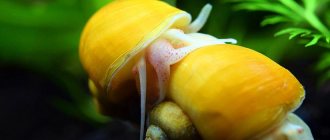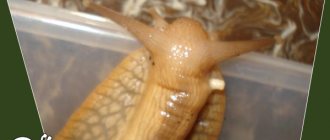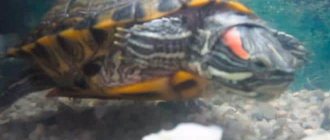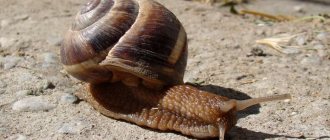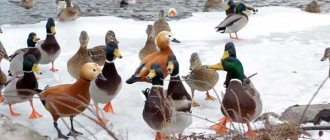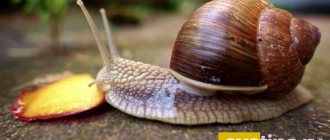In our country, every day there are more and more lovers of exotic animals, they get themselves all kinds of snakes, lizards, spiders and frogs, and now many are carried away by snails! They are grown not only on farms for the purpose of sale to restaurants, where the chef will subsequently prepare a gourmet dish from them. Some types of snails, such as Achatina, have become pets.
Snails have an unusually bright beautiful color, grow to a decent size (it’s not for nothing that they are also called giant African snails), and over time they even get used to and recognize their owner. And besides, there is no hair, like from cats and dogs, which is an important factor for allergy sufferers. But some lovers of our smaller brothers have got snails, but not all of them know what to feed them properly. Well, it is for them that we will conduct this “educational program.”
What do snails eat in nature?
What snails eat in the wild depends directly on their habitat. Mollusks can live:
- in the aquatic environment (fresh and salt water bodies);
- on the land.
It is worth noting that the basis of nutrition for any species of gastropods is plant food, but they are not averse to eating animal protein. The diet of street snails and aquatic inhabitants varies somewhat. The food of aquatic mollusks are:
- fine algae deposits growing on underwater plants, rocks, etc.;
- the aquatic plants themselves;
- dead insects in the water;
- caviar of fish and amphibians.
Forest snails eat:
- shoot bark;
- leaves, shoots, buds of plants;
- mushrooms;
- fruits (vegetables and fruits) that are found in a given area.
Moreover, young snails usually prefer fresh greens, while older snails prefer greens that have already begun to decompose.
Interesting fact! Snails that receive a lot of animal protein in their food become more aggressive in their natural environment and attack their relatives.
Eating vegetables
The use of preventive measures in the garden and summer cottage
It is quite difficult to combat the invasion of gastropods, so it is easier to use preventive measures that can prevent the appearance of these pests in the garden plot or vegetable garden.
First of all, you should provide an environment in the garden that is unfavorable for the existence of these living creatures.
For this purpose, all excess stones and building materials that could create conditions acceptable for gastropods should be removed from the site.
The land should be cultivated in a timely manner to control weeds. It is advisable to mow excess grass in a timely manner.
In order to prevent mollusks from hiding in cracks, the soil should be loosened as often as possible, especially during the period of active vegetative growth of plants. After harvesting, you should thoroughly clean the garden, getting rid of all plant debris.
Clearing the area of plant debris will deprive mollusks of the opportunity to comfortably overwinter in the garden or vegetable garden.
Control of harmful shellfish is an important step in obtaining a full harvest. Therefore, you should take all preventive measures seriously.
The fact is that, despite their small size, gastropods are capable of causing serious harm to all types of vegetation growing in the garden or vegetable garden.
What can you give at home?
At home, it is fashionable to give mollusks a variety of foods in accordance with the regime, which will be discussed below.
Fresh vegetables and fruits
The basis of snail nutrition at home is fiber, namely vegetables and fruits. The following products can be recommended:
- root vegetables: carrots, beets;
- cabbage of all types: cauliflower, Chinese, Brussels sprouts, cabbage;
- pumpkin, zucchini;
- cucumbers, tomatoes;
- legumes: green beans, peas;
- fruits: pears, apples;
- stone fruits: plums, peaches, cherries;
- exotic fruits: bananas, figs, coconut pulp, mango, avocado.
Attention! Before feeding the snail, fruits and vegetables must be thoroughly washed to remove the layer of wax that is often used to cover fruits for transportation.
Frozen vegetables and fruits
At home, snails can be given foods that have been frozen. For shellfish, all items on the list above can be frozen.
Attention! All fruits and vegetables must be thawed (at room temperature or in the microwave) before giving to your pets.
Frozen vegetables
Berries
A domestic snail may well eat berries. The main condition is that they should not contain a lot of acid. Pets will enjoy eating:
- black currant;
- strawberries and wild strawberries;
- raspberries;
- grapes
Greens and herbs
Snails eat grass with great eagerness. The following types of greens can be given as a vitamin supplement:
- lettuce of various types, spinach, asparagus;
- dill, parsley, celery;
- wild plants: dandelions, plantain.
Other
Domestic snails are animals that mainly feed on plant foods. However, other foods must be added to their diet:
- raw edible mushrooms, such as champignons, oyster mushrooms;
- a small amount of boiled poultry, boiled seafood;
- milk;
- boiled or steamed cereals and grains.
Attention! Gammarus, which can be purchased at pet stores, is an excellent nutritional supplement to the diet.
Oyster mushrooms
How to cook food for Achatina?
- Food should not be given to Achatina immediately from the refrigerator; it must only be at room temperature. If you decide to feed the snails soft vegetables or fruits, then they should be finely chopped.
- With solid products you will have to tinker. They need to be finely grated or pureed. It is better not to put soft products in a cage with small Achatina, as they can suffocate if they get inside.
- Newborn Achatina should immediately receive finely chopped greens and thinly sliced carrots, and after a few days they can be “pampered” with lettuce leaves and an apple.
- Sometimes it happens that Achatina ignores some varieties of apples or pears, while others eat with appetite. In this case, try different types of them, and give them those that the snails choose for themselves. And another very important point: immediately accustom the mollusks to the food that you can feed them all year round.
What to feed in winter?
Food in winter should not be significantly different, since domestic snails do not hibernate. In addition to fresh products, you can give frozen ones (see list), following all recommendations.
In winter, you can give dried herbs harvested in summer:
- clover, plantain;
- leaves of oak, currant, birch.
Dried herbs are ground with eggshells.
Also, in winter, it would be useful to place a potted plant in the snail’s home (terrarium, enclosure):
- Kalanchoe;
- aloe;
- oat or wheat sprouts.
Features of feeding snails by species
When choosing a snail for home keeping, you should pay attention that the diet of the species is somewhat different. First of all, it is necessary to dispel one misconception: large snails do not feed on other snails, so you can safely plant snails in one house.
- Large land snails Achatina divide foods into favorite and unloved, and stubbornly refuse the latter.
- Grape snails have a long digestive tract, so despite their small size, they eat quite a lot.
- It is necessary to add tableted algae (sold in pet stores) to the diet of river snails.
- Garden and forest snails feed on wet plant food and need water.
Attention! Snails living in their natural environment are often carriers of microscopic parasites. Therefore, it is worth considering whether the proximity of specially bred “domestic” snails and their “wild” relatives in the same terrarium will cause harm.
River
Feeding during breeding
If you want to get offspring from domestic snails, it is advisable to give them more protein. For example, gammarus, ready-made protein mixtures for pets.
Small snails eat the same things as adults. Mollusks up to 1 month should be given crushed food, gradually switching to eating larger and larger pieces.
How to get rid of grape snails and slugs in your home?
If appropriate measures are not taken to combat gastropods, they can harm both cultivated and ornamental plants so much that they stop developing due to a slowdown in photosynthesis processes.
In addition, the harm consists of a significant reduction in yield.
There are three ways to control these pests. Which are the most popular and widespread among gardeners and summer residents.
These methods of resisting gastropods are:
The mechanical method of control involves collecting snails by hand using tweezers. To facilitate the procedure, it is recommended to make several traps. Such devices will help lure gastropods out of their hiding places.
Traps can be pieces of rags or burlap soaked in beer and placed between rows of plants. During the daytime, snails will hide under such shelters and in the evening they can be easily collected. To kill pests, you can use a saline or regular soap solution.
An ecological method of control is to attract natural enemies of gastropods to the site. In nature, there are several species of animals for which gastropods are a source of food.
Such natural enemies of snails are:
The condition for attracting toads to the site is the construction of a small pond on it. To attract hedgehogs, it is recommended to lay out dog food or place bowls of milk in the area.
A good option in the fight against gastropods is the use of parsley. Sage or garlic. Planting these plants allows you to get rid of the invasion of snails on the site. The odors of these herbs are unacceptable to slugs.
Chemical methods of controlling snails involve using special drugs against them. Such a compound is, for example, metaldehyde. This type of chemical is both a bait for slugs and a poison for them. When using chemical control methods, extreme caution should be taken as the use of chemicals can be harmful to pets and humans.
When processing the area, the access of children and pets to the treated area should be protected.
Prohibited Products
Some types of food for domestic snails are strictly not recommended. This may include:
- products containing bitter or pungent flavorings: onions, garlic, hot peppers;
- plant products with a high content of natural acids: sorrel, citruses, pineapples, cranberries;
- human food: sugar, salt, pasta, sweets;
- dairy products with a high fat content (cheese);
- fatty meat: pork, beef, lamb.
Attention! If you are not sure that a certain type of food is suitable for pet snails, you should not give it so as not to harm your pet’s health.
Nuances of keeping bivalves
Freshwater bivalves can be viviparous (they immediately give birth to offspring consisting of copies of themselves reduced tens of times) or those that grow from larvae.
- Glochidia (parasitic larvae) adhere to other aquatic inhabitants and can grow on the body of a fish or aquatic turtle, for example.
- Veligers (larvae that feed on plankton) can attach to hard objects (snags, stones), and therefore do not cause much trouble, like glochidia. The latter seriously annoy the fish, which is why they often die.
It is also better to keep viviparous mollusks in shrimp tanks, although there is no accurate information about the interexistence of glochidia and crustaceans.
Feeding rules
To feed your pet snails, you should develop a schedule and stick to it. The basic rule here is: the smaller the pet, the less often and less food you need to give it. Large mollusks need to be fed daily, small ones - 3 times a week.
The way mollusks feed is very specific: they have sharp spikes-teeth on their tongues, which they use to scrape off the top layer of food products, like a grater. Therefore, you should not give exclusively crushed food; you should leave pieces of different sizes.
Crushed eggshells
Basic principles of feeding:
- Animals are active at night, so they should be given food in the evening.
- Food should not be placed on the substrate or bottom of the enclosure. It's better to use plates.
- All uneaten food debris must be removed quickly to avoid attracting harmful insects and preventing the development of fungi, which can be destructive to shellfish.
- The snail's home must have a container of clean water. To prevent land mollusks from drowning, the water level should not exceed 1 cm.
- Do not give snails cold food (straight from the refrigerator). Food temperature should be at room temperature or slightly higher.
- To maintain the hardness of the shell, calcium must be added to the diet. It could be:
- crushed eggshells;
- mineral stone or sepia for birds;
- pharmaceutical calcium preparations;
- feed chalk
Advice! For snails, you can use balanced food for fish or pet turtles. However, the basis of the diet should still be fresh fruits and vegetables.
Bottom line
As you can see, feeding snails includes many nuances that you need to know about. Feed your pets correctly, include only permitted foods in your snails’ diet, a list of which can be found in the next article, and your pets will delight you with a healthy appearance and a good appetite!
https://www.youtube.com/watch?v=N_IDsBNQpP4
To other news
01.09.2020


